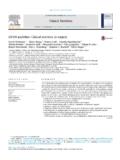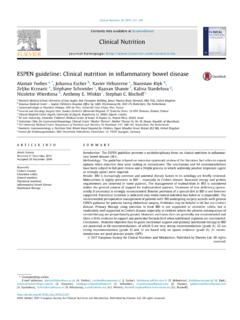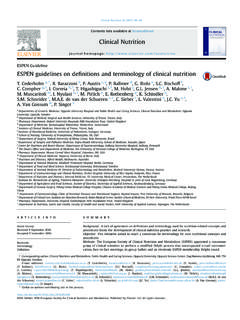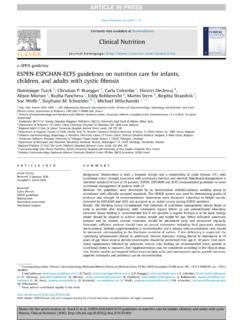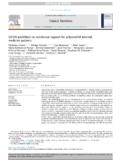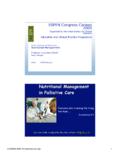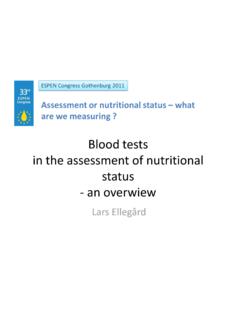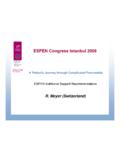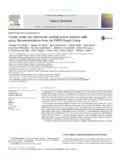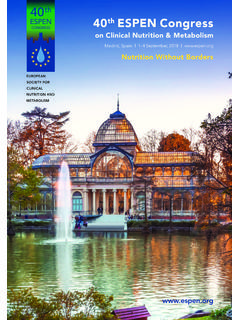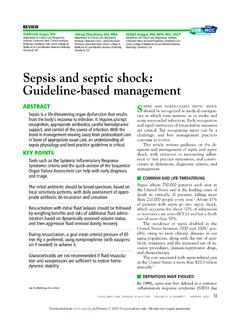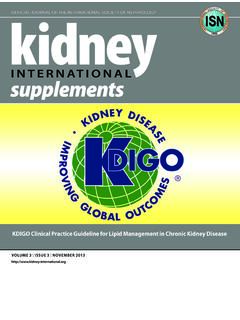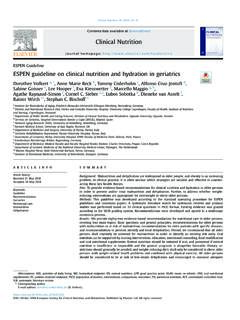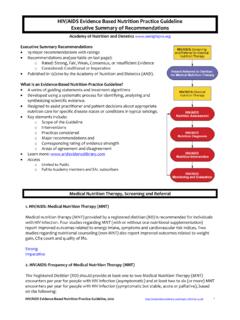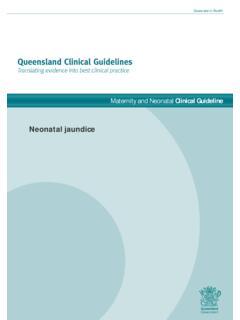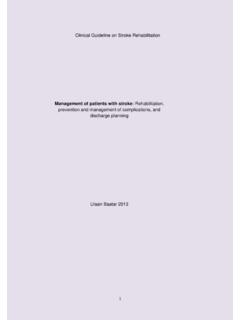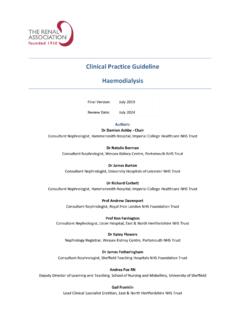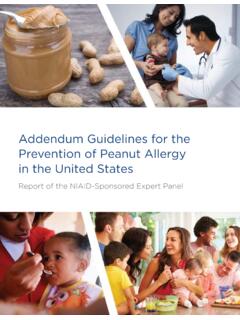Transcription of ESPEN guideline on clinical nutrition in acute and chronic ...
1 ESPEN GuidelineESPEN guideline on clinical nutrition in acute and chronic pancreatitisMarianna Arvanitakisa,*, Johann Ockengab, Mihailo Bezmarevicc, Luca Gianottid, Zeljko Krznari ce, Dileep N. Lobof,g, Christian L oserh, Christian Madli, Remy Meierj,Mary Phillipsk, Henrik H jgaard Rasmussenl, Jeanin E. Van Hooftm, Stephan C. BischoffnaDepartment of Gastroenterology, Erasme University Hospital ULB, Brussels, BelgiumbDepartment of Gastroenterology, Endocrinology and clinical nutrition , Klinikum Bremen Mitte, Bremen, GermanycDepartment of Hepatobiliary and Pancreatic Surgery, Clinic for General Surgery, Military Medical Academy, University of Defense, Belgrade, SerbiadSchool of Medicine and Surgery, University of Milano-Bicocca and Department of Surgery, San Gerardo Hospital, Monza, ItalyeDepartment of Gastroenterology, Hepatology and nutrition , clinical Hospital Centre&School of Medicine, Zagreb.
2 CroatiafGastrointestinal Surgery, Nottingham Digestive Diseases Centre, National Institute for Health Research. (NIHR) Nottingham Biomedical ResearchCentre,Nottingham University Hospitals NHS Trust, University of Nottingham, Queen's Medical Centre, Nottingham, NG7 2UH, UKgMRC Versus Arthritis Centre for Musculoskeletal Ageing Research, School of Life Sciences, University of Nottingham, Queen's Medical Centre, NottinghamNG7 2UH, UKhMedical Clinic, DRK-Kliniken Nordhessen, Kassel, GermanyiDivision of Gastroenterology and Hepatology, Krankenanstalt Rudolfstiftung, Krankenanstaltenverbund Wien (KAV), Vienna, AustriajAMB-Praxis-MagenDarm Basel, Basel, SwitzerlandkDepartment of nutrition and Dietetics, Royal Surrey County Hospital NHS Foundation Trust, Guildford, UKlCentre for nutrition and Bowel Disease, Department of Gastroenterology, Aalborg University Hospital, Faculty of Health, Aalborg University, Aalborg,DenmarkmDepartment of Gastroenterology&Hepatology, Amsterdam Gastroenterology and Metabolism, Amsterdam UMC, University of Amsterdam, Amsterdam,the NetherlandsnInstitute of Nutritional Medicine, University of Hohenheim, Stuttgart, Germanyarticle infoArticle history.
3 Received 29 December 2019 Accepted 8 January 2020 Keywords: acute pancreatitisChronic pancreatitisPancreatic diseasesNutritionNutritional supportMedical nutritionsummaryBoth acute and chronic pancreatitis are frequent diseases of the pancreas, which, despite being of benignnature, are related to a significant risk of malnutrition and may require nutritional support. Acutenecrotizing pancreatitis is encountered in 20% of patients with acute pancreatitis, is associated withincreased morbidity and mortality, and may require artificial nutrition by enteral or parenteral route, aswell as additional endoscopic, radiological or surgical interventions.
4 chronic pancreatitis represents achronic inflammation of the pancreatic gland with development offibrosis. Abdominal pain leading todecreased oral intake, as well as exocrine and endocrine failure are frequent complications of the of the above represent risk factors related to malnutrition. Therefore, patients with chronic pancre-atitis should be considered at risk, screened and supplemented accordingly. Moreover, osteoporosis andincreased facture risk should be acknowledged in patients with chronic pancreatitis, and preventivemeasures should be considered. 2020 Elsevier Ltd and European Society for clinical nutrition and Metabolism.
5 All rights IntroductionAcute pancreatitis (AP) is the most common acute gastrointes-tinal disease requiring hospital admission [1], with the outcomebeing favorable in most cases (80%) [2]. However, acute necrotizingpancreatitis (ANP) may develop in up to 20% of patients and isassociated with significant rates of early organ failure (38%), needfor intervention (38%), and death (15%) [2]. Catabolism is very highin this setting; therefore, nutritional support is one of thecornerstones of management [3]. A significant amount of researchhas shown the superiority of enteral over parenteral nutrition inANP, creating a paradigm shift a decade ago and modifying themanagement strategy [3].
6 Nevertheless, additional questionsregarding the timing, route and type of enteral nutrition (EN), aswell as the place of oral refeeding, are still the objects of pancreatitis (CP) is a disease in which recurrent in-flammatory episodes lead to replacement of the pancreatic pa-renchyma byfibrous connective tissue [4]. The major consequenceof CP is the loss of functional exocrine and endocrine pancreatic*Corresponding Arvanitakis).Contents lists available atScienceDirectClinical Nutritionjournal homepage: 2020 Elsevier Ltd and European Society for clinical nutrition and Metabolism. All rights nutrition 39 (2020) 612e631tissue, thus resulting in both exocrine and endocrine insufficiency[4].
7 Pain is also frequently encountered in patients with CP, andseems to be related to a multitude of factors such as pancreaticneural remodeling and neuropathy, increased intraductal andparenchymal pressure, pancreatic ischemia and acute inflamma-tion during an acute relapse [5]. Both pain and loss of pancreaticfunction can lead to malnutrition in patients with CP [4]. Moreover,other long-term consequences such as osteoporosis are frequentlyoverlooked, despite their potential impact on quality of life in pa-tients with CP. Therefore, screening for malnutrition and nutritionalsupport play a crucial part in the multimodal management requiredin this recent guidelines for AP [2] and CP [4] have beenpublished, a dedicated consensus on nutritional support inpancreatic diseases is MethodsThe present guideline was developed according to the standardoperating procedure for ESPEN guidelines [6].
8 The guideline wasdeveloped by an expert group of 13 authors from eleven Methodology of guideline developmentBased on the standard operating procedures for ESPEN guide-lines and consensus papers, thefirst step of the guideline devel-opment was the formulation of so-called PICO questions whichaddress specificpatient groups orproblems,interventions,compare different therapies and areoutcome-related [6]. In total,31 PICO questions were created and split into two main chapters, acute pancreatitis and chronic Pancreatitis . To answer thesePICO questions, a literature search was performed to identify suit-able meta-analyses, systematic reviews and primary studies, pub-lished from 1977 up to December 2018.
9 The PICO questions wereallocated to subgroups/experts for the different subjects whocreated 42 recommendations and seven statements. For gradingthe literature, the grading system of the Scottish IntercollegiateGuidelines Network (SIGN) was used [7]. Allocation of studies tothe different levels of evidence is shown inTable 1. Supportive ofthe recommendations, the working group added commentaries tothe recommendations where the bases of the recommendations recommendations were graded according to the levels ofevidence assigned (Table 2). The wording of the recommenda-tions reflect the grades of recommendations, level A is indicatedby shall , level B by should and level 0 by can/may.
10 The goodpractice point (GPP) is based on experts' opinions due to the lackof studies, here, the wording can be chosen voting on the recommendations was performed on All ESPEN members were invitedto agree or disagree with the recommendations and to comment onthem. Afirst draft of the guideline was also made available to theparticipants; on that occasion 36 recommendations and all sevenstatements reached an agreement of>90%, six recommendationsreached an agreement of 75e90% and no recommendation anagreement of<75%. Those recommendations with an agreement of>90%, which means a strong consensus (Table 3) were passeddirectly; all others were revised according to the comments andvoted on again during a consensus conference, which took place on29th April 2019.
